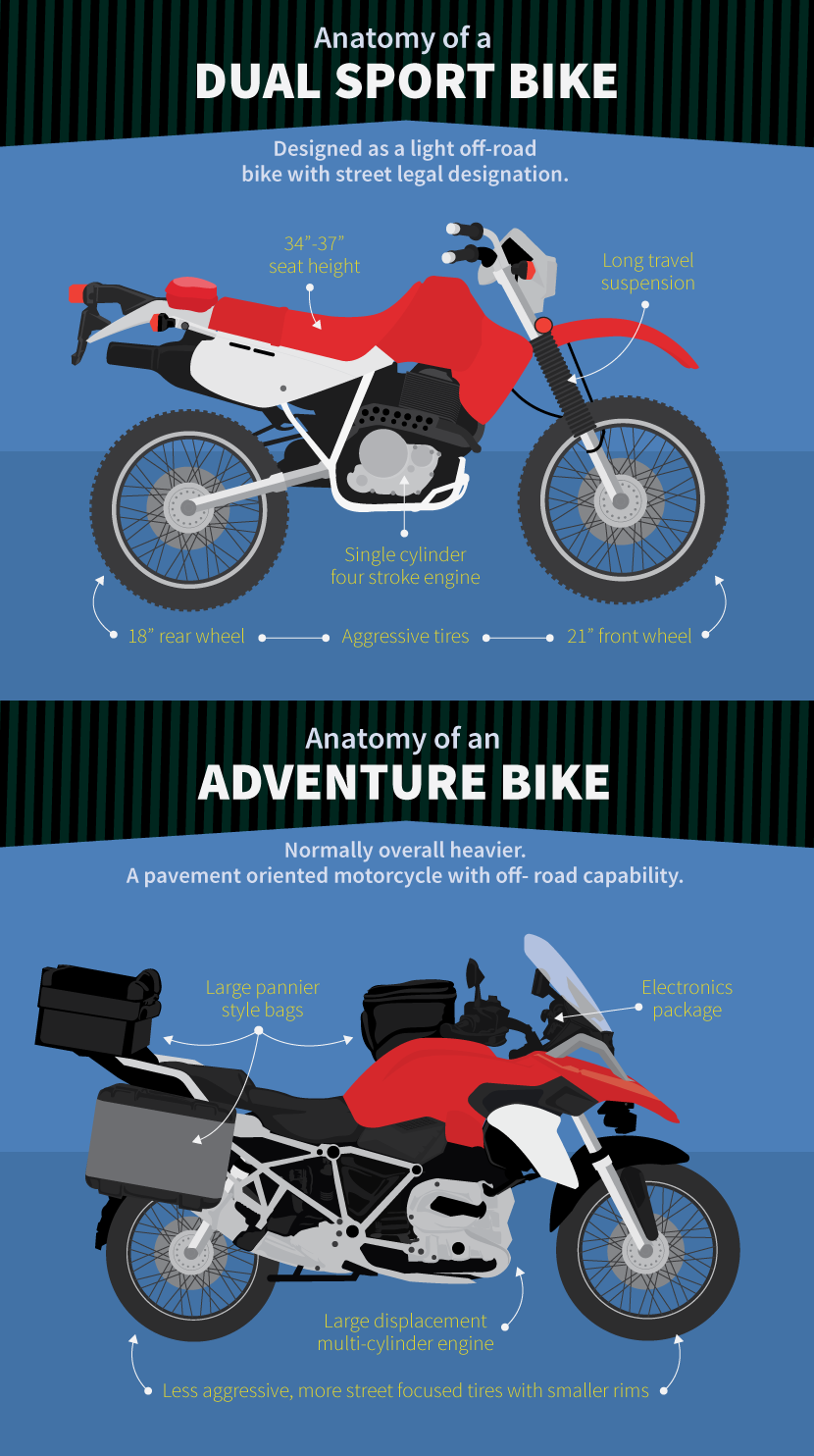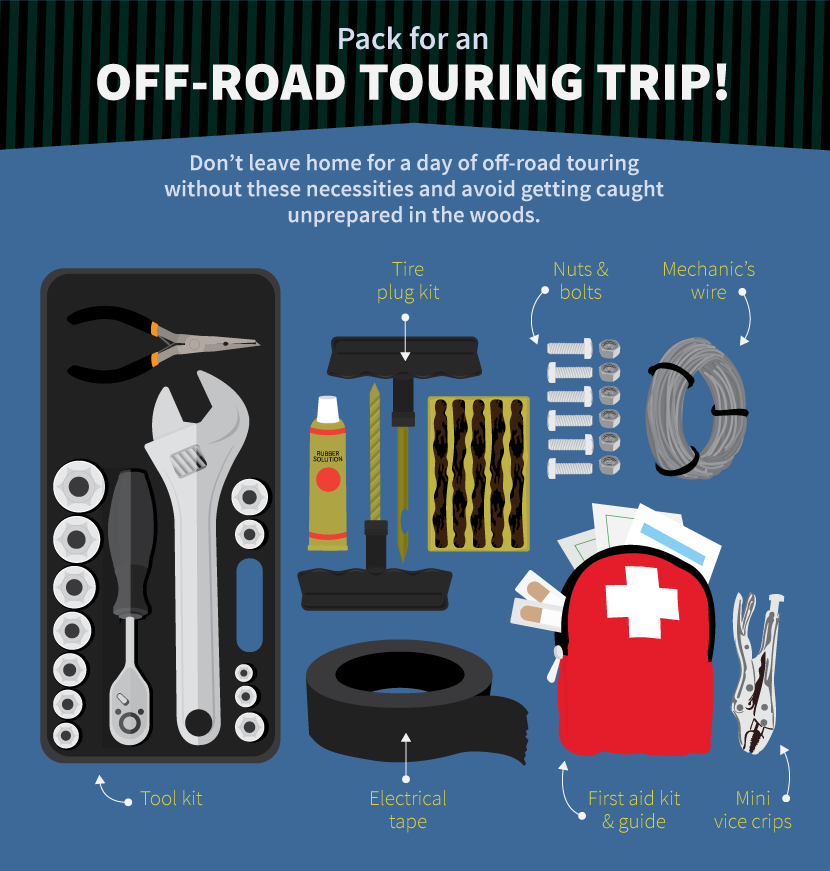Off-Road Motorcycle Touring
Street bikes are fun, but in the end the ride is always somewhat predicable. Throw a little dirt into the mix, however, and even a ride to the corner store becomes an adventure.
Dual Sport vs. Adventure Bike
Should you want to get involved in dual sport or adventure riding, you’ll need a dedicated bike. These days a mildly warmed-over street bike like the ’64 CL 72 Honda Scrambler that I rode back in the day just won’t cut it. The question is: What sort of bike best suits your needs?
Dual Sport Bikes
Dual sports are street legal motorcycles designed primarily as off-road bikes. With a few exceptions, dual sports are powered by single-cylinder four-stroke engines that typically displace between 125 and 650 cc. Following normal off-road practice, they have long travel suspensions, usually with some provision to adjust damping and spring preload, and plenty of ground clearance. Likewise, they normally use a 21” front wheel, which lets the tire ride up and over obstacles and reduces steering effort, especially on soft surfaces, and an 18” rear tire. Physically, dual sports tend to be tall – figure on a seat height of between 34 and 37 inches – and light, with an average weight of something around 350lbs.
Although dual sports are primarily designed for off-road use, the majority of them make excellent street bikes, so they’re a sound choice for the rider that may have to make one bike serve all their needs. By the same token, it’s worth mentioning that the high end dual sports, particularly those from the European manufacturers, are really thinly disguised race bikes that have been made street legal. As such they’re expensive, and may not be the best choice if you’re new to this.
Adventure Bikes
Adventure bikes are pavement-oriented motorcycles that have been designed to include some degree of off-road capability. As befits their mission, they are by nature larger, more sophisticated, and considerably more expensive than dual sport motorcycles. Typical attributes of an adventure bike are a large displacement multi-cylinder engine; an electronics package that includes features like ride mode control, ABS, electronic suspension adjustment; and plug-ins for your personal electronic devices. They generally offer some sort of weather protection, and large pannier-style bags will be included or available as an option. Although they generally have more ground clearance than pure street bikes, they don’t normally have as much as a dual sport. In most cases they’ll also have smaller rims, similar to those used on street bikes, with the less dirt-oriented versions often using cast wheels. Adventure bikes can be trail ridden, if the trail isn’t terribly challenging or if the pilot is exceptionally brave, and there are exceptions; some of the “rally” type of adventure bikes are extremely competent no matter how tough the trail. But overall most adventure bikes should be considered the two-wheel equivalent of an SUV.
Which to Choose?
The bottom line here is that while a dual sport and an adventure bike share similar DNA, in many ways they’re as different from each other as chalk is from cheese. If you want a touring bike that won’t be put off by broken pavement, unpaved roads, and the occasional off-road foray, an adventure bike is probably your best choice. On the other hand, if you want a street legal dirt bike that can be ridden to the trailhead, or one that can carry you to school or work during the week, and still give your buddies a good run for their money through the woods or even enter the occasional off-road race, then look toward the dual sports.

Equipment
An off-road bike can carry you farther into the wilderness in 10 minutes than most of us can walk in two hours. And while a broken street bike is inconvenient, help is seldom more than a phone call away. But if your dual sport or adventure bike breaks down in some remote off-road location, you’re probably going to be on your own, so as the Boy Scouts say: “Be prepared.”
Adventure bikes tend to have ample storage space, so carrying tools, medical supplies, and a few well-chosen spares, along with anything else you might need, shouldn’t present much of a problem. Depending on how long you’re going to be out there, I’d recommend that, in addition to your travel needs, clothing, personal items, and whatever else you deem important enough to carry, you also pack the following:
- A good first aid kit – one that’s got enough stuff in it to do you or anyone that’s injured some good, and it should include at least a rudimentary guide to first aid.
- A decent tool kit. If your bike doesn’t come with one you can trust, go out and buy the best grade tools you can afford. At the very least, your tool kit should include tools to remove a wheel, replace a spark plug, and tighten up anything that comes loose. On the last off-road ride I was on, my buddy’s KTM sprocket bolts came loose, locking up the rear wheel. The fix was simple, but if we hadn’t had the right Allen wrench it would have been a long, slow push home. If the bike has tubeless tires, a tire plug kit should be included along with some means of inflating the tire. If the bike uses tube-type tires, a spare tube and the tools needed to install it can come in mighty handy. I’d also recommend learning how to change the tube before it goes flat.
- A small vice grip. This is an absolute must-have. I’ve seen them used to replace broken shift, brake, and clutch levers and even used to operate a broken throttle cable. They’re pretty good at removing stuck or rounded-off bolts as well.
- A few well-chosen spares. Among other things I always carry a few nuts and bolts, a few feet of mechanic’s wire and a roll of electrical tape.

Because dual sport bikes don’t always have a lot of space, you’ll have to get a little creative in the way you carry things. Some guys tape tools and spare parts to out-of-the-way places on their bike. Some use tool kits that mount to the fenders, and some like to wear a fanny or back pack that can be crammed full. I’m a fanny pack guy, and in mine I generally carry a small adjustable wrench, a few dedicated wrenches that fit my bike’s fasteners. A tire inflator/sealer, and of course, my vice grips. A final tip here: a lot of the time my riding buddies and I divide up the tool-carrying chores. John carries the tire irons, I have the tube(s), and Ric has the axle wrench. Doing it that way allows us to carry a lot more gear, with a lot less hassle.

Travel tips:
If you ride alone, make sure someone knows where you’re going, the general route you’re taking, and your estimated time of arrival.
When riding in a group, establish any ground rules – before you let out the clutch – and make sure you’re all on the same page.
Lastly, no one should be out in the woods by themselves. I don’t care how close to home you are, riding alone can get you hurt or worse. Preferably any serious off-road ride should include three riders; that way if someone gets hurt, one person can stay with the injured rider, the other can go for help.
Embed the article on your site

